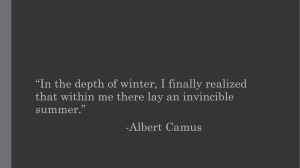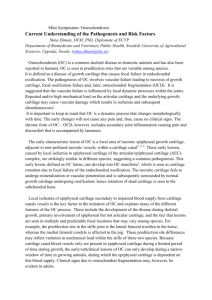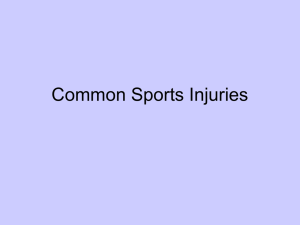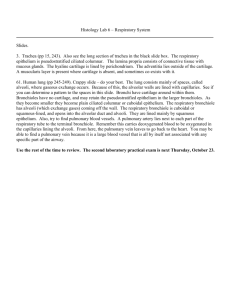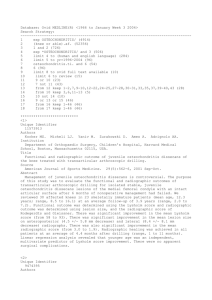What Have We Learned?
advertisement
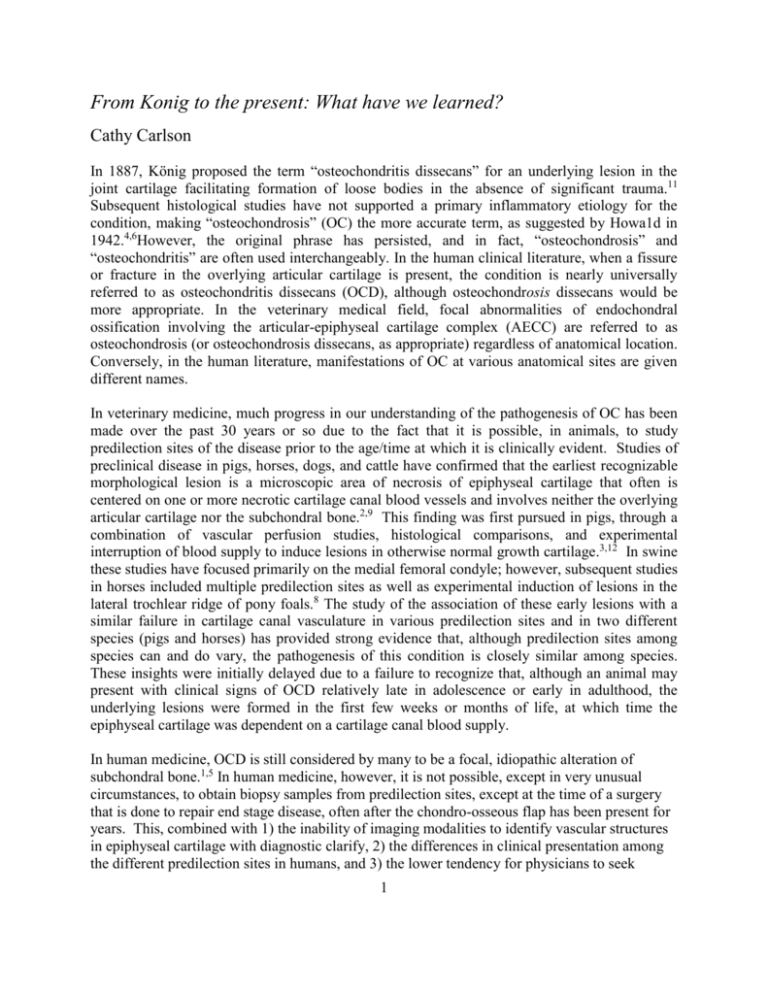
From Konig to the present: What have we learned? Cathy Carlson In 1887, König proposed the term “osteochondritis dissecans” for an underlying lesion in the joint cartilage facilitating formation of loose bodies in the absence of significant trauma.11 Subsequent histological studies have not supported a primary inflammatory etiology for the condition, making “osteochondrosis” (OC) the more accurate term, as suggested by Howa1d in 1942.4,6However, the original phrase has persisted, and in fact, “osteochondrosis” and “osteochondritis” are often used interchangeably. In the human clinical literature, when a fissure or fracture in the overlying articular cartilage is present, the condition is nearly universally referred to as osteochondritis dissecans (OCD), although osteochondrosis dissecans would be more appropriate. In the veterinary medical field, focal abnormalities of endochondral ossification involving the articular-epiphyseal cartilage complex (AECC) are referred to as osteochondrosis (or osteochondrosis dissecans, as appropriate) regardless of anatomical location. Conversely, in the human literature, manifestations of OC at various anatomical sites are given different names. In veterinary medicine, much progress in our understanding of the pathogenesis of OC has been made over the past 30 years or so due to the fact that it is possible, in animals, to study predilection sites of the disease prior to the age/time at which it is clinically evident. Studies of preclinical disease in pigs, horses, dogs, and cattle have confirmed that the earliest recognizable morphological lesion is a microscopic area of necrosis of epiphyseal cartilage that often is centered on one or more necrotic cartilage canal blood vessels and involves neither the overlying articular cartilage nor the subchondral bone.2,9 This finding was first pursued in pigs, through a combination of vascular perfusion studies, histological comparisons, and experimental interruption of blood supply to induce lesions in otherwise normal growth cartilage.3,12 In swine these studies have focused primarily on the medial femoral condyle; however, subsequent studies in horses included multiple predilection sites as well as experimental induction of lesions in the lateral trochlear ridge of pony foals.8 The study of the association of these early lesions with a similar failure in cartilage canal vasculature in various predilection sites and in two different species (pigs and horses) has provided strong evidence that, although predilection sites among species can and do vary, the pathogenesis of this condition is closely similar among species. These insights were initially delayed due to a failure to recognize that, although an animal may present with clinical signs of OCD relatively late in adolescence or early in adulthood, the underlying lesions were formed in the first few weeks or months of life, at which time the epiphyseal cartilage was dependent on a cartilage canal blood supply. In human medicine, OCD is still considered by many to be a focal, idiopathic alteration of subchondral bone.1,5 In human medicine, however, it is not possible, except in very unusual circumstances, to obtain biopsy samples from predilection sites, except at the time of a surgery that is done to repair end stage disease, often after the chondro-osseous flap has been present for years. This, combined with 1) the inability of imaging modalities to identify vascular structures in epiphyseal cartilage with diagnostic clarify, 2) the differences in clinical presentation among the different predilection sites in humans, and 3) the lower tendency for physicians to seek 1 insights from naturally occurring disease in animals, have lead to a conclusion held by many that osteochondrosis has a different pathogenesis not only among species but among predilection sites within a species (human). The recent development of MRI techniques to visualize cartilage canal vessels in vivo are likely to change this perception, as these will allow characterization of the cartilage canal vasculature in humans and the identification of subclinical disease well before it manifests clinically.7,10 Although OC is the first orthopaedic disease to be definitely linked to a failure in cartilage canal blood supply, it is likely that, once it is possible to visualize epiphyseal vasculature in vivo, other developmental orthopaedic diseases in both animals and humans (e.g., hip dysplasia, acetabular impingement, orthopaedic complications secondary to sickle cell anemia, etc.) will follow. REFERENCES 1 Baker CL, 3rd, Romeo AA, Baker CL, Jr.: Osteochondritis dissecans of the capitellum. The American journal of sports medicine 2010:38(9):1917-1928. 2 Carlson CS, Hilley HD, Meuten DJ: Degeneration of cartilage canal vessels associated with lesions of osteochondrosis in swine. Veterinary pathology 1989:26(1):47-54. 3 Carlson CS, Meuten DJ, Richardson DC: Ischemic necrosis of cartilage in spontaneous and experimental lesions of osteochondrosis. Journal of orthopaedic research : official publication of the Orthopaedic Research Society 1991:9(3):317-329. 4 Edmonds EW, Polousky J: A Review of Knowledge in Osteochondritis Dissecans: 123 Years of Minimal Evolution from Konig to the ROCK Study Group. Clinical orthopaedics and related research 2012. 5 Hixon AL, Gibbs LM: Osteochondritis dissecans: a diagnosis not to miss. American family physician 2000:61(1):151-156, 158. 6 Howald H: Zur kenntnis der osteochondrosis dissecans (osteochondrotos dissecans). Archiv für orthopädische und Unfall-Chirurgie 1942:41:730-788. 7 Nissi MJ, Toth F, Zhang J, Schmitter S, Benson M, Carlson CS, et al.: Susceptibility weighted imaging of cartilage canals in porcine epiphyseal growth cartilage ex vivo and in vivo. Magn Reson Med 2013. 8 Olstad K, Hendrickson EH, Carlson CS, Ekman S, Dolvik NI: Transection of vessels in epiphyseal cartilage canals leads to osteochondrosis and osteochondrosis dissecans in the femoro-patellar joint of foals; a potential model of juvenile osteochondritis dissecans. Osteoarthritis Cartilage 2013:21(5):730-738. 9 Olstad K, Ytrehus B, Ekman S, Carlson CS, Dolvik NI: Epiphyseal cartilage canal blood supply to the tarsus of foals and relationship to osteochondrosis. Equine veterinary journal 2008:40(1):30-39. 10 Toth F, Nissi MJ, Zhang J, Benson M, Schmitter S, Ellermann J, et al.: Histological confirmation and biological significance of cartilage canals demonstrated using high field MRI in swine at predilection sites of osteochondrosis. J Orthop Res 2013:In press. 11 Wagoner G, Chon BNE: Osteochondritis dissecans: a résumé of the theories of etiology and the consideration of heredity as an etiologic factor. Arch Surg 1931:23:1-25. 2 12 Ytrehus B, Andreas Haga H, Mellum CN, Mathisen L, Carlson CS, Ekman S, et al.: Experimental ischemia of porcine growth cartilage produces lesions of osteochondrosis. Journal of orthopaedic research : official publication of the Orthopaedic Research Society 2004:22(6):1201-1209. 3

